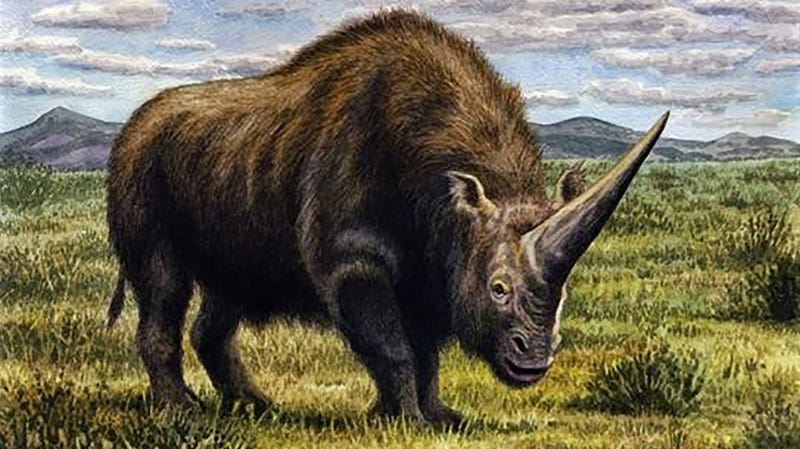Extinct 'Siberian Unicorns' Walked the Earth Alongside Modern Humans

Os paleontólogos conhecem cerca de 250 espécies de rinocerontes, das quais apenas cinco ainda existem hoje. Entre os mais espetaculares desses rinocerontes estava o Elasmotherium sibiricum - o unicórnio siberiano. Para os neandertais e os humanos modernos que viveram ao lado e possivelmente caçaram essa enorme criatura na Europa Oriental e Ásia Central, deve ter sido uma visão impressionante e profundamente intimidadora. Evidências fósseis sugerem que o Elasmotherium pesava mais de 3,5 toneladas, estava coberto por uma espessa camada de pelos e ostentava um chifre de porções bíblicas, possivelmente com até 1 metro de comprimento.
Por mais impressionante que tenha sido, os unicórnios siberianos acabaram morrendo. A datação anterior de fósseis sugeriu uma data de expiração em algum ponto entre 200.000 e 100.000 anos atrás, muito antes da extinção da megafauna do Quaternário em larga escala, que ocorreu há 40.000 anos. Nova pesquisa publicada esta semana na Nature Ecology & Evolution está oferecendo uma estimativa mais confiável, datando o fim do Elasmotherium em algum ponto entre 39.000 e 35.000 anos atrás. A extinção dos unicórnios siberianos, portanto, pode agora ser conectada à extinção da megafauna quaternária tardia, um evento que testemunhou o fim do mamute lanoso, do alce irlandês e do gato com dentes de sabre.
Writing in their
new study, led by Adrian Lister from the Natural History Museum in
London, the researchers said “no absolute dating, genetic analysis or
quantitative ecological assessment of this species [had] been
undertaken,” which explains why the prior extinction estimate was so far
off. The new study overcomes these shortcomings, and includes the use
of updated fossil dating techniques.
For the study, an international team of researchers from the UK, Netherlands, and Russia took a closer look at 23 Elasmotherium
specimens, including a pristine skull kept at the Natural History
Museum. An improved radiocarbon dating technique resulted in the revised
extinction dates; many of the samples were slathered in preservation
materials, requiring careful preparation for the carbon dating.
“Some
of the samples we studied were very contaminated which made the
radiocarbon dating very challenging,” Thibaut Devièse, a researcher at
Oxford’s School of Archaeology and a co-author of the study, said in a
statement. “For this reason we used a novel method of extracting a
single amino acid from the bone’s collagen in order to ensure highly
accurate results.”
In addition, the researchers succeeded, for the first time ever, in extracting DNA from the Elasmotherium
fossils. The ensuing genetic analysis showed that Siberian unicorns
split from modern rhinos around 43 million years ago, “settling a debate
based on fossil evidence and confirming that the two lineages had
diverged by the Eocene,” the researchers wrote in the study. These Ice
Age rhinos are the last species of a “highly distinctive and ancient lineage,” according to the research.
Siberian
unicorns lived alongside anatomically modern humans and Neanderthals.
That ancient hominids may have preyed upon these oversized rhinos is not
as outrageous a proposition as it may seem. Early humans, likely a form
of Homo erectus, were hunting rhinos in the Philippines around 700,000 years ago. But while rhinos were on the hominid menu, this new research suggests climate change, and not hunters, was responsible for Elasmotherium’s demise.
Esses rinocerontes, como sabemos agora da nova pesquisa, viveram durante a Idade do Gelo pouco antes do Último Máximo Glacial - o estágio no qual as camadas de gelo cobriam sua maior área, cerca de 26.500 anos atrás. A Terra estava propensa a dramáticas mudanças climáticas durante este período, produzindo secas, desertificação, uma queda no nível do mar e a constante invasão das geleiras. Essas rupturas climáticas resultaram fatais para muitas espécies, dentre elas o Elasmotherium.
Para o unicórnio siberiano, isso significou uma perda de habitat e, consequentemente, o desaparecimento de uma fonte crítica de alimento, como o novo estudo supõe. Em experimentos, Lister e seus colegas analisaram as razões isotópicas estáveis dos rinocerontes fossilizados. Os pesquisadores procuraram ligar várias plantas com os níveis de isótopos de carbono e nitrogênio em seus dentes. Os unicórnios siberianos, como revelaram essas análises, viviam em um ambiente de estepe seco, onde mastigavam gramíneas duras e secas. Os rinocerontes, com seu estilo de vida de pastoreio altamente especializado e com números populacionais naturalmente baixos, não conseguiram se adaptar com rapidez suficiente às condições de rápida mudança, sugere o estudo.
A changing climate, and not humans, were thus responsible for the demise of E. sibiricum. Interestingly, it’s a conclusion that jibes well with similar, but unrelated, research,
in which scientists claim that humans weren’t responsible for many
megafaunal extinctions of the Ice Age. Sadly, the same cannot be said
for the ongoing sixth mass extinction, which is most certainly our fault.
Nenhum comentário:
Postar um comentário
Observação: somente um membro deste blog pode postar um comentário.